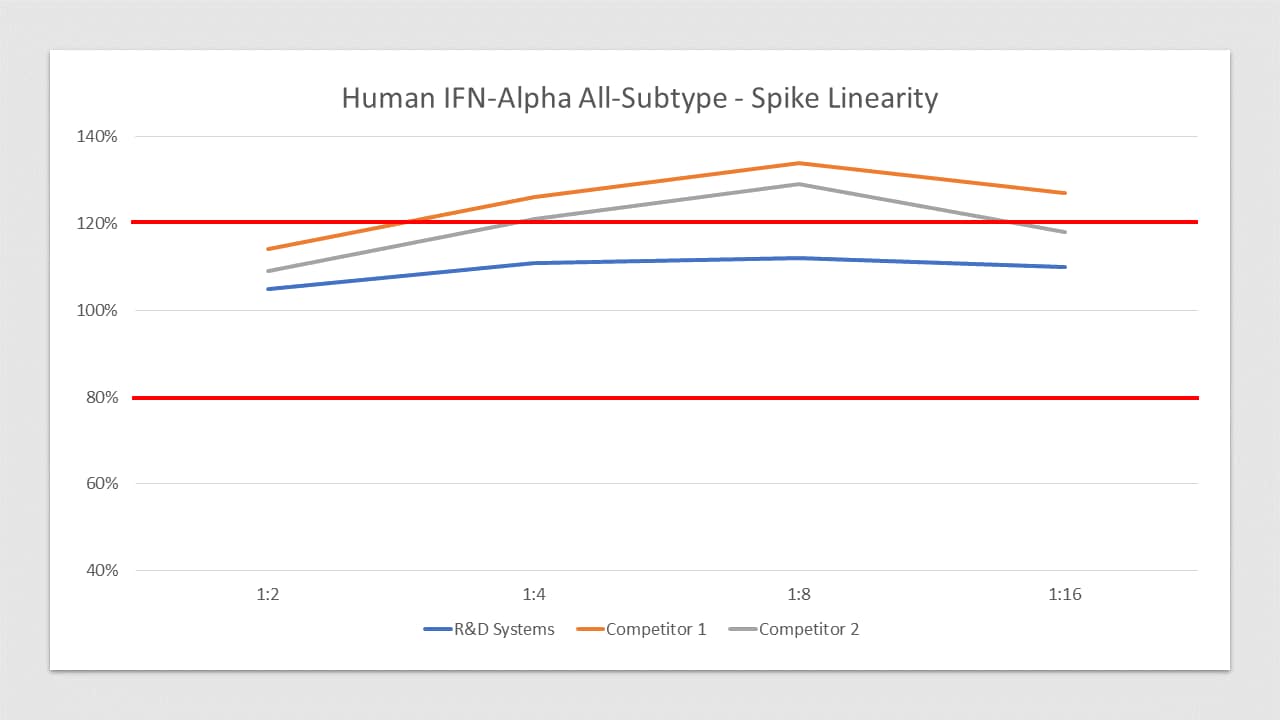Human IFN-alpha All Subtype ELISA Kit - Quantikine Best Seller
R&D Systems, part of Bio-Techne | Catalog # DFNAS0

Key Product Details
Assay Length
Sample Type & Volume Required Per Well
Sensitivity
Assay Range
Product Summary for Human IFN-alpha All Subtype Quantikine ELISA Kit
Product Specifications
Measurement
Detection Method
Conjugate
Reactivity
Specificity
Cross-reactivity
Interference
Precision
Intra-Assay Precision (Precision within an assay) Three samples of known concentration were tested twenty times on one plate to assess intra-assay precision.
Inter-Assay Precision (Precision between assays) Three samples of known concentration were tested in twenty separate assays to assess inter-assay precision. Assays were performed by at least three technicians using two lots of components.
Cell Culture Supernates, EDTA Plasma, Heparin Plasma, Serum
| Intra-Assay Precision | Inter-Assay Precision | |||||
|---|---|---|---|---|---|---|
| Sample | 1 | 2 | 3 | 1 | 2 | 3 |
| n | 20 | 20 | 20 | 20 | 20 | 20 |
| Mean (pg/mL) | 178 | 340 | 698 | 185 | 354 | 737 |
| Standard Deviation | 3.62 | 8.35 | 20.9 | 9.50 | 20.5 | 41.0 |
| CV% | 2.0 | 2.5 | 3.0 | 5.1 | 5.8 | 5.6 |
Recovery for Human IFN-alpha All Subtype Quantikine ELISA Kit
The recovery of human IFN-alpha spiked to levels throughout the range of the assay in various matrices was evaluated.
| Sample Type | Average % Recovery | Range % |
|---|---|---|
| Cell Culture Media (n=4) | 101 | 96-103 |
| EDTA Plasma (n=4) | 92 | 89-96 |
| Heparin Plasma (n=4) | 91 | 88-96 |
| Serum (n=4) | 89 | 83-94 |
Linearity
To assess the linearity of the assay, samples containing and/or spiked with high concentrations of human IFN-alpha were serially diluted with calibrator diluent to produce samples with values within the dynamic range of the assay.

Scientific Data Images for Human IFN-alpha All Subtype Quantikine ELISA Kit
Human IFN-Alpha All Subtype Quantikine Spiked Linearity Competitor Comparison
IFN-alpha is spiked at high concentration in various matrices and diluted with appropriate Calibrator Diluent to produce samples with values within the dynamic range of the assay. R&D Systems linearity is between 105%-112% compared to 114%-134% and 109%-129% for the top competitors.Human IFN-Alpha All Subtype Spiked Recovery Competitor Comparison
IFN-alpha is spiked at three known concentrations throughout the range of the assay and run to measure response of the spiked sample matrix. R&D Systems serum recovery is 104% compared to 74% and 163% for the top competitors.Human IFN-alpha All Subtype ELISA Standard Curve
Preparation and Storage
Shipping
Stability & Storage
Background: IFN-alpha
Long Name
Alternate Names
Entrez Gene IDs
Gene Symbol
Additional IFN-alpha Products
Product Documents for Human IFN-alpha All Subtype Quantikine ELISA Kit
Product Specific Notices for Human IFN-alpha All Subtype Quantikine ELISA Kit
For research use only


